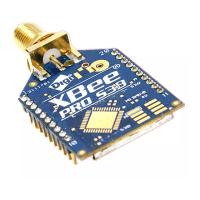XBee‐PRO®900HP/XBee‐PRO®XSCRFModules
©2014DigiInternationalInc. 79
After completing the transmissions of the test link packets the executing radio will send the following data
packet to the requesting radio's Test Link Result Cluster (0x0094) on endpoint (0xE6). If the requesting radio
is configured to operate in API mode then the following information will be output as an API Explicit RX
Indicator Frame:
Example:
Suppose that the link between radio A (SH/SL = 0x0013a20040521234) and radio B (SH/
SL=0x0013a2004052abcd) is to be tested by transmitting 1000 40 byte packets. The following
API packet should be sent to the serial interface of the radio on which the results should be
output, radio C. Note that radio C can be the same radio as radio A or B (whitespace used to
delineate fields, bold text is the payload portion of the packet):
7E 0020 11 01 0013A20040521234 FFFE E6 E6 0014 C105 00 00 0013A2004052ABCD 0028
03E8 EB
And the following is a possible packet that could be returned:
7E 0027 91 0013A20040521234 FFFE E6 E6 0094 C105 00 0013A2004052ABCD 0028 03E8
03E7 0064 00 0A 50 53 52 9F
(999 out of 1000 packets successful, 100 retries used, RR=10, maxRSSI=-80dBm, minRSSI=-
83dBm, avgRSSI=-82dBm)
If the result field is not equal to zero then an error has occurred. The other fields in the packet should be
ignored. If the Success field is equal to zero then the RSSI fields should be ignored.
Trace Routing
In many applications it is useful to determine the route which a DigiMesh unicast takes to its destination. This
information is especially useful when setting up a network or diagnosing problems within a network. The Trace
Route API option of Tx Request Packets (see the API section of this manual for a description of the API frames)
causes routing information packets to be transmitted to the originator of a DigiMesh unicast by the
intermediate nodes.
When a unicast is sent with the Trace Route API option enabled, the unicast is sent to its destination radios
which forward the unicast to its eventual destination will transmit a Route Information (RI) packet back along
the route to the unicast originator. A full description of Route Information API packets can be found in the API
section of this manual. In general they contain addressing information for the unicast and the intermediate
hop for which the trace route packet was generated, RSSI information, and other link quality information.
Number of Bytes
Field Name Description
8
Destination address
The address with which the radio
tested its link
2
Payload size
The size of the test packet that was
sent to test the link.
2
Iterations
The number of packets which were
sent.
2
Success
The number of packets successfully
acknowledged.
2
Retries
The total number of MAC retries used
to transfer all the packets.
1
Result
0x00 - command was successful
0x03 - invalid parameter used
1
RR
The maximum number of MAC retries
allowed.
1
maxRSSI
The strongest RSSI reading observed
during the test.
1
minRSSI
The weakest RSSI reading observed
during the test.
1
avgRSSI
The average RSSI reading observed
during the test.

